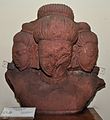The Many Faces and Arms Depicted in Hindu Art Are Representative of
Hindu art encompasses the artistic traditions and styles culturally connected to Hinduism and accept a long history of religious association with Hindu scriptures, rituals and worship.
Groundwork [edit]
Hinduism, with its 1.2 billion followers, makes up about 15-16 % of the earth's population[1] and as such the civilization that ensues it is full of different aspects of life that are effected by art. In that location are 64 traditional arts that are followed that start with the classics of music and range all the way to the application and adornment of jewellery.[2] Since religion and culture are inseparable with Hinduism recurring symbols such as the gods and their reincarnations, the lotus flower, actress limbs, and fifty-fifty the traditional arts make their appearances in many sculptures, paintings, music, and trip the light fantastic.
History [edit]
Earliest depictions of Hindu deities (3rd-2nd centuries BCE) [edit]
It is thought that earlier the adoption of rock sculpture, there was an older tradition of using clay or woods to correspond Indian deities, which, because of their inherent fragility, accept not survived.[v]
There are no remains of such representations, but an indirect testimony appears in the some dial-marked coins of the Mauryan Empire, as well as the coinage of the Indo-Greek king Agathocles, who issued coins with the paradigm of Indian deities, together with legends in the Brami script, circa 180-190 BCE.[4] [3] The deity illustrated in some of the punch-marked coins of the 3rd century BCE is now generally thought to be Balarama, with his attributes: a plough in his raised left manus and pestle in his raised right hand.[6] Also among the beginning known illustrations of Hindu deities appear on Hellenistic coinage, as witnesses by the Indo-Greeks in the northwest of the Indian subcontinent, and they are generally identified as Balarama-Samkarshana and Vasudeva-Krishna, together with their attributes, specially the Gada mace and the turn for the former, and the Vishnu attributes of the Shankha (a pear-shaped case or conch) and the Sudarshana Chakra cycle for the latter.[iv] [7] According to Bopearachchi, the headdress is actually a misrepresentation of a shaft with a one-half-moon parasol on tiptop (chattra), as seen in after statues of Bodhisattvas in Mathura. It is therefore thought that images, predating the coins but now lost, served as models to the engravers.[7]

The Katra architrave, perchance representing Brahmins and the cult of the Shiva Linga, Mathura, circa 100 BCE[viii]

Worship of Shiva Linga by Gandharvas, 2d-1st century BCE
The dancing girls on some of the coins of Agathocles and Pantaleon are too sometimes considered as representations of Lakshmi, the consort of Vishnu, but besides a Goddess of abundance and fortune for Buddhists, or Subhadra, the sister of Krishna and Balarama.[7]
Early reliefs (1st century BCE) [edit]
Past 100 BCE in the art of Mathura, reliefs start to represent more complex scenes, defining, according to Sonya Rhie Quintanilla, an historic period of "iconic diversification and narrative maturation". Some reliefs, such as the "Katra architrave", possibly representing Brahmins and the cult of the Shiva Linga. These reliefs from Mathura are dated to circa 100 BCE.[8] These examples of narrative reliefs, although few remain, are as refined and intricate as the better known Buddhist narrative reliefs of Bharhut, Sanchi or Amaravati.[9] [10]
Hindu fine art under the Kushans (2nd-3rd century CE) [edit]

The Caturvyūha Viṣṇu: Vāsudeva and other members of the Vrishni clan.[11] Vāsudeva (avatar of Vishnu) is fittingly in the center with his heavy decorated mace on the side and holding a conch, his elder brother Balarama to his right under a snake hood, his son Pradyumna to his left (lost), and his grandson Aniruddha on superlative.[xi] [12] 2nd century CE, Mathura Museum.
Hindu fine art started to develop fully from the 1st to the 2nd century CE, and there are only very few examples of artistic representation before that time.[xiii] Hindu fine art found its starting time inspiration in the Buddhist art of Mathura. The three Vedic gods Indra, Brahma and Surya were really first depicted in Buddhist sculpture, as attendants in scenes commemorating the life of the Buddha, such as his Birth, his Descent from the Trāyastriṃśa Sky, or his retreat in the Indrasala Cave.[13] During the time of the Kushans, Hindu fine art progressively incorporated a profusion of original Hindu stylistic and symbolic elements, in contrast with the general balance and simplicity of Buddhist art. The differences appear in iconography rather than in style.[xiv] It is mostly considered that information technology is in Mathura, during the time of the Kushans, that the Brahmanical deities were given their standard class:
"To a great extent it is in the visual rendering of the various gods and goddesses of theistic Brahmanism that the Mathura artist displayed his ingenuity and inventiveness at their best. Along with almost all the major cult icons Visnu, Siva, Surya, Sakti and Ganapati, a number of subsidiary deities of the faith were given tangible form in Indian art here for the first time in an organized mode. In view of this and for the variety and multiplicity of devotional images then made, the history of Mathura during the offset three centuries of the Christian era, which coincided with the rule of the Kusanas, tin very well be chosen revolutionary in the development of Brahmanical sculpture"
—Pran Gopal Paul and Debjani Paul, in Brahmanical Imagery in the Kuṣāṇa Fine art of Mathurā: Tradition and Innovations [fifteen]
Some sculptures during this period suggest that the concept of the avatars was starting to sally, as images of "Chatur-vyuha" (the iv emanations of Vishnu) are appearing.[xvi] The famous "Caturvyūha Viṣṇu" statue in Mathura Museum is an attempt to show in 1 composition Vāsudeva (avatar of Vishnu) together with the other members of the Vrishni clan of the Pancharatra organisation: Samkarsana, Pradyumna and Aniruddha, with Samba missing, Vāsudeva being the cardinal deity from whom the others emanate.[11] [12] The back of the relief is carved with the branches of a Kadamba tree, symbolically showing the human relationship being the different deities.[11] The depiction of Vishnu was stylistically derived from the type of the ornate Bodhisattvas, with rich jewelry and ornate headdress.[17]
-
Lord's day God Surya, also revered in Buddhism, Kushan Period
-

Shiva Linga worshipped by Indo-Scythian,[xviii] or Kushan devotees, 2nd century CE.
-

The Hindu God Shiva, 3rd century CE. Mathura or Ahichchhatra.
Hindu fine art under the Guptas (quaternary-sixth century CE) [edit]
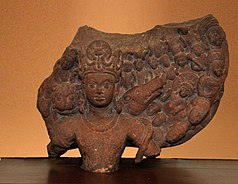
Visnu Visvarupa: Vishnu as three-headed cosmic creator, showing Vishnu with a human head, flanked past his avatars (the caput of a king of beasts for Narasimha, the muzzle of a boar for Varaha) with a multitude of beings on his aureole, symbol of the emanations resulting from his creative power. 5th century CE, Mathura.[20]
The start known creation of the Guptas relate to Hindu fine art at Mathura is an inscribed pillar recording the installation of two Shiva Lingas in 380 CE under Chandragupta Two, Samudragupta's successor.[21]
Development of the iconography of Vishnu [edit]
Until the 4th century CE, the worship of Vāsudeva-Krishna seems to have been much more of import than that of Vishnu.[20] With the Gupta catamenia, statues focusing on the worship of Vishnu start to appear, and supplant earlier statues which are now attributed to Vāsudeva-Krishna.[20] Many of the statues of Vishnu appearing from the 4th century CE, such as the Vishnu Caturanana ("Four-Armed"), employ the attributes and the iconography of Vāsudeva-Krishna, but add an aureole starting at the shoulders.[xx]
Other statues of Vishnu show him as three-headed (with an implied quaternary head in the back), the Visnu Vaikuntha Chaturmurti or Chaturvyuha ("Four-Emanations") blazon, where Vishnu has a human head, flanked by the muzzle of a boar (his avatar Varaha) and the caput of a panthera leo (his avatar Narasimha), 2 of his well-nigh of import and ancient avatars, laid out upon his aureole.[20] Recent scholarship considers that these "Vishnu" statues still show the emanation Vāsudeva Krishna as the central homo-shaped deity, rather than the Supreme God Vishnu himself.[22] [twenty]
A further variation is Vishnu as three-headed cosmic creator, the Visnu Visvarupa, showing Vishnu with a human head, again flanked by the muzzle of a boar the head of a lion, but with a multitude of beings on his aureole, symbol of the numerous creations and emanations resulting from his creative ability.[xx] These sculptures can be dated to the fifth century CE.[20]
Incorporation of Lakshmi [edit]
In the 3rd-fourth century CE, Lakshmi, which had been an independent Goddess of prosperity and luck, was incorporated in the Vaishnava pantheon equally the consort of Vishnu.[23] She thus became the Hindu goddess of wealth, good fortune, prosperity and beauty.[24]
-

4-faced Vishnu Chaturvyuha ("Four-Emanations"), quaternary-fifth century, Mathura
-

Vishnu Caturanana ("Four-Armed"), 5th century, Mathura
-

Vishnu statue, 5th century, Mathura.
-
Bust of Brahma, Circa 6th Century CE
-
Ganesha, Gupta Period, Mathura
Medieval period (8th-16th century) [edit]
Hindu art became largely prevalent from the Medieval period onward. It was accompanied past the decline of Buddhism in the Indian subcontinent.
-

Sarvatobhadra Shiva Linga Representing Brahma Vishnu Maheshwar and Surya, Circa ninth Century CE
-
Architectural Fragment with Divine Figures, circa 10th century CE
-
Decorative Door Jamb - Medieval Flow
-
Burn God, Medieval Period
-
Four-armed Seated Vishnu in Meditation, Mediaeval Period
-
Jain Tirthankara Neminath, Circa 12th Century CE
-
Continuing Surya, Medieval Period
-
Standing Twin Vishnu, Circa 10th Century CE
-
X-armed Ganesha, Medieval Menstruation
Early modern period (16th-19th century) [edit]
-
Krishna Lifting Govardhan Mound, circa 19th Century CE
-
Lakshmi Narayan Seated on Garuda - Bronze - Circa 18th Century CE
Modern period [edit]
-
-
Lord Krishna Killing to Kaliyanaga Demon, Statuary, Modern Historic period
-
Homo Milking Cow with Calf, Bronze, Mod Age
-
Seated Shiva, Modern Period
-
Stupa, Bronze, Modern Age
Popular Dance and Music Art Forms [edit]
Natya Shastra and centuries of Hindu cultural traditions have given rise to several art forms. Some of which are:
- Bharatanatyam
- Kuchipudi
- Manipuri
- Mohiniyattam
- Odissi
- Sattriya
- Bhagavata Mela
- Yakshagana
- Carnatic Music
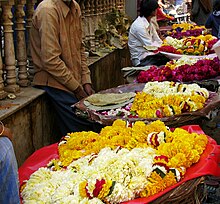
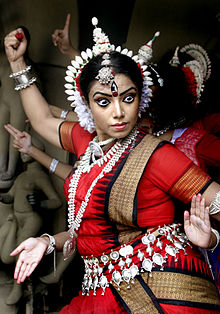
A Hindu dance depicting the goddess Durga
64 Traditional Arts[26] [edit]
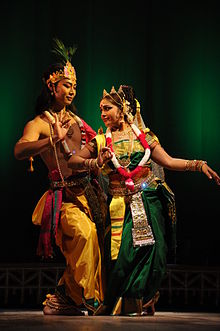
Hindu dances as role of ritual
- Singing
- Instrumental music
- Learning music in Hindu culture was a difficult task before the 20th century considering of a necessary nascence into a gharana. Afterwards the early on 1920s integration of anyone wanting to learn classical Hindustani music could. An average ensemble unremarkably includes a harmonium (which was brought to Republic of india past westerners), flute, veena, sitar, swaramandala, and a tabla. Many of the songs have strong themes that are related to theology such as a god'south favorite pastimes, praise of any god whether they be in their original course from "the trinity" or the god'southward reincarnation, even stories of the creation of earth. Since instrumental music is a performance art it must follow strict guidelines that come from the treatise Natya Shastra.[27]
- Dancing
- Painting
- Indian variety - the dissimilar types of folk paintings are proud for Indian culture which reflects beauty, tradition and heritage of Bharat. In that location are many types of traditional paintings like Madhubani, Rajsthani, Batik-Art, Patachitra, Gond, Mandala, Tribal Art Warli, Pithora, Bengali, Nirmal, Mysore, Tanjore paintings etc. which are the expressions of beloved, almighty, beauty, truth, tradition and fine art of each and every region of the India.
- Brow adornments
- Rangoli: Making decorative floral and grain designs on the floor
- Dwelling and temple flower arranging
- Personal grooming
- Mosaic tiling
- Bedroom arrangements
- Creating music with h2o
- Splashing and squirting with water
- Cloak-and-dagger mantras
- Making flower garlands
- Caput adornments
- Dressing
- Drapery- The art of mantle has progressed over fourth dimension. At one signal both men and women wore dhotis but around the 14th century that changed and women'south fashion became more intricate thus creating the sari. The drapery involved distinguishes the wearer's sense of taste, occupation, and social status. The fabrics chosen range from cotton and synthetic fabrics all the way to silk. The fabric chosen depends on what occasion the wearer is going to use the item of habiliment for. The draping of the sari comes in four different families: Marvari, Dravidian, Tribal, and Nivi. The family that the wearer chooses depends on the wearer'southward personal gustation. The way an particular of clothing is draped tells a lot about the wearer such equally expression of creativity, progression of fashion, and where the user comes from.[28]
- Costume decorations
- Perfumery
- Jewelry making
- Magic and illusions
- Ointments for charm and virility
- Manual dexterity
- Skills of cooking, eating and drinking
- Beverage and dessert preparation
- Sewing (making and mending garments)
- Embroidery
- Playing Vina and drum
- Riddles and rhymes
- Verse games
- Tongue twisters and hard recitation
- Literary recitation
- Drama and story telling
- Drama in its early essence was performed mainly by male person troupes and was often integrated with many of the other traditional fine art forms such as verse, music, and story telling. Since drama is a operation art information technology as well follows the Natya Shastra guidelines.[29]
- Poetry composition games
- Piece of furniture caning
- Erotic devices and cognition of sexual arts
- Crafting wooden article of furniture
- Architecture and house construction
- Distinguishing between ordinary and precious stones and metals
- Metal-working
- Gems and mining
- Gardening and horticulture
- Games of wager involving animals
- Training parrots and mynas to speak
- Hairdressing
- Coding messages
- Speaking in code
- Knowledge of foreign languages and dialects
- Making flower carriages
- Spells, charms and omens
- Making simple mechanical devices
- Memory training
- Game of reciting verses from hearing
- Decoding messages
- The meanings of words
- Dictionary studies
- Prosody and rhetoric
- Impersonation
- Aesthetic dressing
- Games of dice
- The game of akarsha (a dice game played on a board)
- Making dolls and toys for children
- Personal etiquette and animal preparation
- Knowledge of dharmic warfare and victory
- Physical culture
Numerical list [edit]
- gita — art of singing.
- vadya — art of playing on musical instruments.
- nritya — art of dancing.
- natya — fine art of theatricals.
- alekhya — art of painting.
- viseshakacchedya — art of painting the face and torso with colored unguents and cosmetics.
- tandula-kusuma-bali-vikara — art of preparing offerings from rice and flowers.
- pushpastarana — art of making a covering of flowers for a bed.
- dasana-vasananga-raga — art of applying preparations for cleansing the teeth, clothes, and painting the body.
- mani-bhumika-karma — art of making the precious stone garlands.
- sayya-racana — art of roofing the bed.
- udaka-vadya — art of playing on music in water.
- udaka-ghata — art of splashing water on ground.
- citra-yoga — fine art of practically applying an admixture of colors.
- malya-grathana-vikalpa — art of designing a preparation of wreaths or garlands.
- sekharapida-yojana — art of practically setting the coronet on the head.
- nepathya-yoga — art of practically dressing
- karnapatra-bhanga — art of decorating the tragus of the ear.
- sugandha-yukti — fine art of practical application of aromatics.
- bhushana-yojana — art of applying or setting ornaments.
- aindra-jala — art of jugglery.
- kaucumara — a kind of fine art.
- hasta-laghava — art of sleight of hand.
- citra-sakapupa-bhakshya-vikara-kriya — art of preparing varieties of foods - curries, soups, sweetmeats
- panaka-rasa-ragasava-yojana — fine art of preparing palatable drinks and fruit juices
- suci-vaya-karma — art of needleworks and weaving.
- sutra-krida — fine art of playing with thread.
- vina-damuraka-vadya — art of playing on lute and small x-shaped pulsate.
- prahelika — fine art of making and solving riddles.
- pratimala — art of caping or reciting poetry for verse equally a trial for memory or skill.
- durvacaka-yoga — art of practicing language hard to be answered by others.
- pustaka-vacana — art of reciting books.
- natikakhyayika-darsana — art of enacting curt plays and anecdotes.
- kavya-samasya-purana — art of solving enigmatic verses.
- pattika-vetra-bana-vikalpa — fine art of designing preparation of shield, cane and arrows.
- tarku-karma — fine art of spinning by spindle.
- takshana — art of carpentry.
- vastu-vidya — fine art of engineering.
- raupya-ratna-pariksha — fine art of testing silver and jewels.
- dhatu-vada — fine art of metallurgy.
- mani-raga jnana — art of judging jewels.
- akara jnana — fine art of mineralogy.
- vrikshayur-veda-yoga — art of practicing medicine or medical treatment, by herbs.
- mesha-kukkuta-lavaka-yuddha-vidhi — art of knowing the mode of fighting of lambs, cocks and birds.
- suka-sarika-prapalana (pralapana)? — art of maintaining or knowing chat between male and female cockatoos.
- utsadana — art of healing or cleaning a person with perfumes.
- kesa-marjana-kausala — fine art of combing hair.
- akshara-mushtika-kathana — art of talking with fingers.
- mlecchita-kutarka-vikalpa — fine art of fabricating barbarous or foreign sophistry.
- desa-bhasha-jnana — art of knowing provincial dialects.
- pushpa-sakatika-nirmiti-jnana — art of knowing prediction by heavenly vocalization or knowing training of toy carts by flowers.
- yantra-matrika — art of mechanics.
- dharana-matrika — fine art of the use of amulets.
- samvacya — art of chat.
- manasi kavya-kriya — art of composing verse mentally.
- kriya-vikalpa — art of designing a literary work or a medical remedy.
- chalitaka-yoga — art of practicing equally a builder of shrines
- abhidhana-kosha-cchando-jnana — art of the utilize of lexicography and meters.
- vastra-gopana — art of concealment of cloths.
- dyuta-visesha — art of knowing specific gambling.
- akarsha-krida — art of playing with die or magnet.
- balaka-kridanaka — art of using children's toys.
- vainayiki vidya — art of enforcing discipline.
- vaijayiki vidya — art of gaining victory.
- vaitaliki vidya — art of enkindling master with music at dawn
- aaaah vidya — art of enkindling audio from Mani.
Historic Texts on Fine art Practices [edit]
- Natya Shastra
- The Natya Shastra is the leading guide to the Hindu performing arts. It is based on the Natya Veda, which no longer exists, and is roughly 37 chapters long with six,000 slokas.[30]
Cities Dedicated to the Production of Art [edit]
- Raghurajpur
- This city is solely dedicated to the production of artwork that is driven by the divine forces of Hinduism and these artworks are produced in a traditional fashion. The city is located in Eastern India (Orissa) and at one point this city was at take a chance of being completely destroyed due to British rule[ citation needed ]. During this fourth dimension religion and the power of the kings were being overthrown and as such there was no reason for a metropolis to be whose main purpose is to supply traditional art. Later on this crunch occurred the metropolis began to exclusively base of operations itself on agronomics until a human being named Jacnnath Mopatra led a training center for chitrakars. This revolution began product of the traditional fine art works in one case once again in the 1950s and since the work being produced is known internationally.[31]
Mutual Symbols [edit]
- Extra Limbs-Actress limbs are seen on many of the Hindu deities in paintings and sculptures. The actress limbs testify how much ability the god is capable of considering of their ability to perform many tasks at once. Such equally the goddess Sarasvati ever has a minimum of iv artillery. Two of the artillery will be playing a vina, representing the tuning of her knowledge, prayer beads in another hand and a scripture in another, both of these items are used to represent her devotion to her spirituality. Since she is the goddess of learning and art we see that she is very capable and very powerful in her area of expertise.[32]
- Lotus Flower-The lotus flower is another mutual item seen constantly throughout the arts. The lotus flower represents purity, beauty, prosperity, fertility, and transcendence.[33] The reason the flower shows these attributes is due to the procedure in which the lotus blossom goes through in order to blossom. The flower grows out of mud and rests atop the water in which it grows showing the hardship information technology must suffer in lodge to achieve maximum dazzler. Many deities have their name based on the Sanskrit word for lotus such as Lakshimi.[34]
See also [edit]
References [edit]
- ^ "The Global Religious Landscape - Hinduism". A Written report on the Size and Distribution of the World'due south Major Religious Groups every bit of 2010. The pew foundation. Retrieved 31 March 2013.
- ^ "Center of Hinduism: Sanskrit and Sanskriti (Culture)." 2004, 30 Mar 2009. < http://hinduism.iskcon.com/lifestyle/801.htm Archived 2010-07-29 at the Wayback Machine>.
- ^ a b Bopearachchi, Osmund. Achaemenids and Mauryans: Emergence of Coins and Plastic Arts in India.
- ^ a b c d Neelis, Jason (2010). Early Buddhist Transmission and Trade Networks: Mobility and Commutation Within and Across the Northwestern Borderlands of Due south Asia. BRILL. pp. 102–103. ISBN978-90-04-18159-five.
- ^ "The folk art typifies an older plastic tradition in clay and wood which was at present put in rock, as seen in the massive Yaksha statuary which are also of exceptional value every bit models of subsequent divine images and man figures." in Agrawala, Vasudeva Sharana (1965). Indian Art: A history of Indian art from the earliest times up to the third century A. D. Prithivi Prakashan. p. 84.
- ^ "Various attempts were fabricated past numismatists to identify the human being figures holding various attributes, appearing on the Regal series of the punch-marked coins dated to the third century BCE. The recent article by Wilfried Pieper has proposed a comprehensive survey of these coins with Vaiṣṇava divinities. The god most probably holding a plough in his raised left hand and pestle in his raised correct hand is no uncertainty Balarāma." in Bopearachchi, Osmund. Achaemenids and Mauryans: Emergence of Coins and Plastic Arts in India.
- ^ a b c Osmund Bopearachchi, 2016, Emergence of Viṣṇu and Śiva Images in India: Numismatic and Sculptural Testify
- ^ a b Quintanilla, Sonya Rhie (2007). History of Early Rock Sculpture at Mathura: Ca. 150 BCE - 100 CE. BRILL. pp. 47–49, Fig. 29 and 30. ISBN9789004155374.
- ^ Quintanilla, Sonya Rhie (2007). History of Early Stone Sculpture at Mathura, ca. 150 BCE - 100 CE. BRILL. p. 42. ISBN9789047419303.
- ^ Kumar, Raj (2003). Essays on Indian Art and Architecture. Discovery Publishing Firm. pp. fifty–51. ISBN9788171417155.
- ^ a b c d Paul, Pran Gopal; Paul, Debjani (1989). "Brahmanical Imagery in the Kuṣāṇa Art of Mathurā: Tradition and Innovations". East and West. 39 (1/4): 132–136, for the photograph p.138. ISSN 0012-8376. JSTOR 29756891.
- ^ a b Srinivasan, Doris (1979). "Early Vaiṣṇava Imagery: Caturvyūha and Variant Forms". Archives of Asian Art. 32: 39–forty. ISSN 0066-6637. JSTOR 20111096.
- ^ a b Paul, Pran Gopal; Paul, Debjani (1989). "Brahmanical Imagery in the Kuṣāṇa Fine art of Mathurā: Tradition and Innovations". East and Westward. 39 (i/4): 125. ISSN 0012-8376. JSTOR 29756891.
- ^ Honour, Hugh; Fleming, John (2005). A World History of Art. Laurence King Publishing. p. 244. ISBN978-i-85669-451-3.
- ^ Paul, Pran Gopal; Paul, Debjani (1989). "Brahmanical Imagery in the Kuṣāṇa Art of Mathurā: Tradition and Innovations". East and West. 39 (1/4): 111–143. ISSN 0012-8376. JSTOR 29756891.
- ^ Singh, Upinder (2008). A History of Ancient and Early on Medieval Republic of india: From the Stone Age to the 12th Century. Pearson Education Republic of india. p. 439. ISBN978-81-317-1677-9.
- ^ Bautze-Picron, Claudine (2013). "A neglected Aspect of the Iconography of Viṣṇu and other Gods and Goddesses". Journal of the Indian Society of Oriental Arts. XXVIII–XXIX: 81–92.
- ^ Paul, Pran Gopal; Paul, Debjani (1989). "Brahmanical Imagery in the Kuṣāṇa Art of Mathurā: Tradition and Innovations". East and West. 39 (1/iv): 128. ISSN 0012-8376. JSTOR 29756891.
- ^ Rosenfield, John M. (1967). The Dynastic Arts of the Kushans. University of California Press. p. 93.
- ^ a b c d east f chiliad h i For English summary, see folio 80 Schmid, Charlotte (1997). Les Vaikuṇṭha gupta de Mathura : Viṣṇu ou Kṛṣṇa?. pp. 60–88.
- ^ a b "Collections-Virtual Museum of Images and Sounds". vmis.in. American Institute of Indian Studies.
- ^ "Because they date to a flow when the Pancharatra sect was about influential, these 2 images are probably best identified as Chaturvyuha (or Four-Vyuha) Vishnu. The central face up is that of Vishnu's most supreme, well-nigh transcendent vyuha, or emanation, known as Vasudeva. The subsequent, less abstruse vyuhas, in the class of a panthera leo and a boar, appear at either side, with another vyuha implied at the back. The positions of the lion and boar heads differ in these 2 pieces, indicating that there was some disagreement about the way the viewer should read such an icon." "Brooklyn Museum". world wide web.brooklynmuseum.org.
- ^ "By virtually the tertiary/4th century CE, Shri Lakshmi was captivated into the Vaishnava pantheon every bit the consort of Vishnu" in Singh, Upinder (2008). A History of Ancient and Early Medieval India: From the Stone Age to the 12th Century. Pearson Education Bharat. p. 438. ISBN978-81-317-1677-9.
- ^ James Thousand. Lochtefeld (2002). The Illustrated Encyclopedia of Hinduism: A-M . The Rosen Publishing Group. pp. 385–386. ISBN978-0-8239-3179-8 . Retrieved fifteen October 2016. ; Quote: "[Goddess] Lakshmi is associated with wealth, skillful fortune, and prosperity, and is considered the apotheosis of all these things."
- ^ Ashvini Agrawal 1989, p. 98. sfn error: no target: CITEREFAshvini_Agrawal1989 (help)
- ^ Himalayan Academy. "Kala 64: Hindu - Hinduism Dictionary on Kala 64." 20 April 2009 < http://www.experiencefestival.com/a/Kala_64/id/60455>.
- ^ Dr. Beck, Guy. "Hindu music, at present and into the future." Hinduism Today October/November/December 2007. 28-31. <https://world wide web.hinduismtoday.com/magazine/october-november-december-2007/2007-10-the-magic-of-hindu-music/>
- ^ Boulanger, Chantal. "The Remarkable Indian Art of Draping." Hinduism Today. October/November/December 2008. 60-62. <https://www.hinduismtoday.com/mag/june-1998/1998-06-that-due south-a-wrap/>
- ^ "Dance and Drama." Heart of Hinduism. 2004, 12 Mar 2009. < http://hinduism.iskcon.com/lifestyle/803.htm>
- ^ "Natya Shastra: Encyclopedia Two." 29 April 2009. < http://world wide web.experiencefestival.com/a/Natya_Shastra_-_Text_and_title/id/1793036>
- ^ Dr. Mohanty, M.P. "Living, Painting, Worshipping Fine art." Hinduism Today. July/August/September 2007. 54-59. <https://www.hinduismtoday.com/mag/july-baronial-september-2007/2007-07-living-painting-worshiping-art/>
- ^ Stephen Knapp. "Saravasti, the Goddess of Learning." 20 Mar 2009. < http://www.stephen-knapp.com/sarasvati_goddess_of_learning.htm>
- ^ Anil K. Goel, Lucknow. "God'due south Favorite Flower." Hinduism Today. 1999. 15 Apr 2009. <https://www.hinduismtoday.com/magazine/july-1999/1999-07-god-s-favorite-flower/>.
- ^ "Lotus-Hindu Symbols" Religion Facts. 2007. 15 Apr 2009. < http://www.religionfacts.com/hinduism/symbols/lotus.htm>.
murray-priorcabou1994.blogspot.com
Source: https://en.wikipedia.org/wiki/Hindu_art

